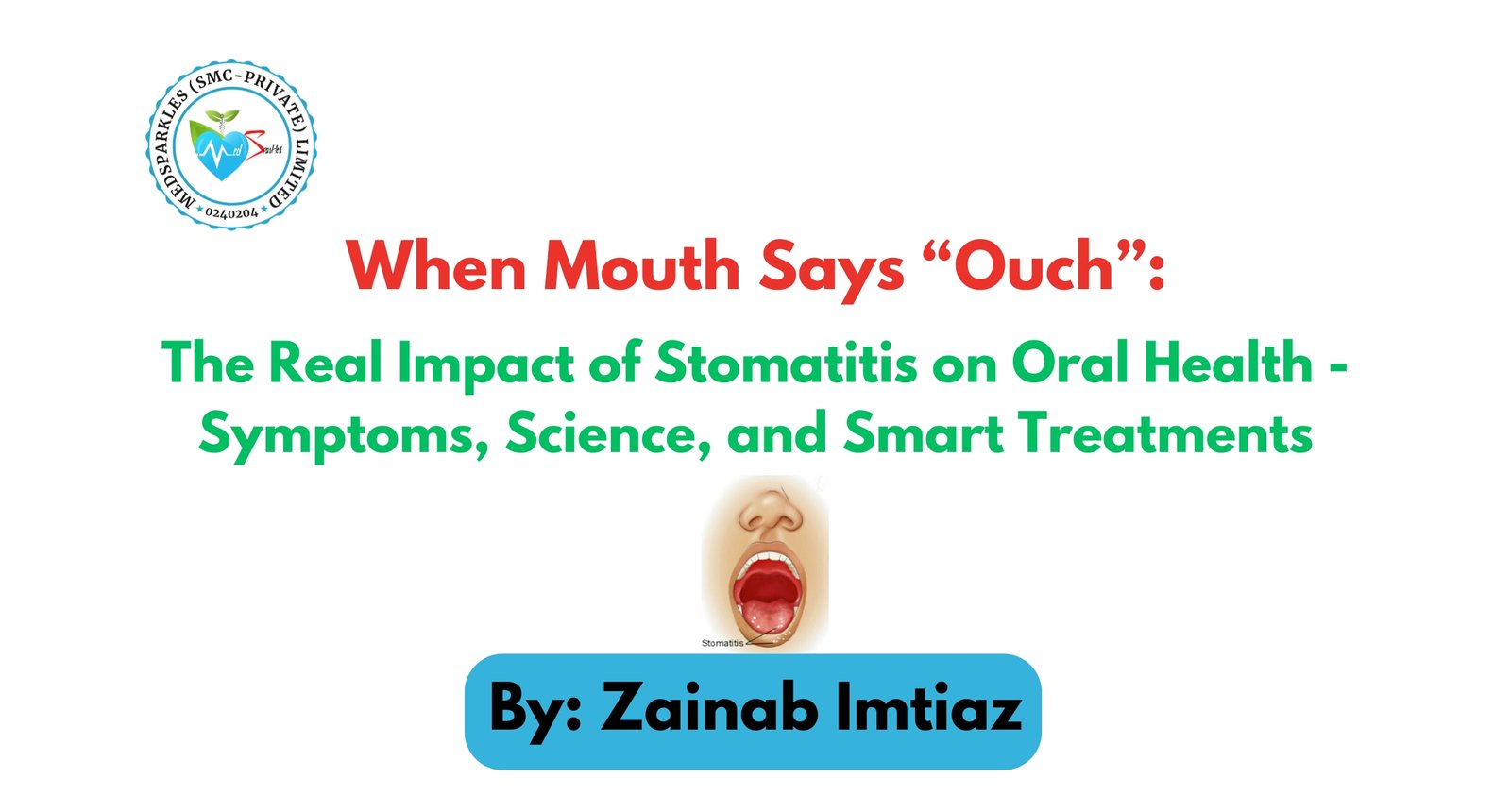Stomatitis, a medical term mainly used when there is an inflammation in the lining of the mouth, is one of those common problems that can range from a tiny nuisance to a major medical setback. A single canker sore can make food taste awful; widespread mucositis during chemotherapy can stop a patient from eating, cause severe pain, and even force a delay in cancer treatment. Here, I explain the main types of stomatitis, how they affect oral health and daily life, the evidence-based treatments we use, and practical steps patients and clinicians can take right away.
Understanding the common types of stomatitis:
Stomatitis is a descriptive term – it simply means mucosal inflammation. The most important types for clinicians and patients are:
- Recurrent aphthous stomatitis (RAS, “canker sores”): painful, shallow ulcers that mainly affect non-keratinized surfaces (inside cheeks, inner lips, soft palate). They are often classified as minor, major, or herpetiform.
- Herpetic (HSV) gingivostomatitis: primary herpes simplex virus type-1 infection that commonly produces multiple, painful oral ulcers and systemic symptoms (fever, irritability), most often seen in young children but possible in adults.
- Oral mucositis: a diffuse, often severe mucosal injury seen as a predictable complication of certain chemotherapies, bone-marrow transplantation, and head/neck radiotherapy. It can cause widespread ulceration, bleeding, severe pain, and nutritional compromise.
- Traumatic/contact or allergic/drug-related stomatitis: caused by mechanical injury (sharp tooth, denture), contact allergens, or medication reactions.
However, confusing an aphthous ulcer with herpetic disease, or failing to recognize cancer therapy-related mucositis, leads to ineffective care and unnecessary suffering.
Signs, symptoms, and the real-world impact
Symptoms vary with type and severity, but the common problems are:
- Pain that interferes with chewing, swallowing, speaking, and tooth brushing.
- Visible ulcers or sloughing mucosa, sometimes covered with a yellowish membrane.
- Systemic signs (fever, malaise) with primary herpetic infections.
- Widespread mucosal loss, bleeding, and infection risk with therapy-related mucositis.
The downstream effects are not trivial: poor oral intake can cause weight loss and malnutrition; inability to maintain oral hygiene increases secondary infection risk, and in oncology settings, severe mucositis can force treatment delays or dose reductions. These consequences make early, evidence-based management essential.
How do we make the diagnosis?
Diagnosis is usually clinical and begins with a focused history and oral exam:
- History: onset and pattern (single vs recurrent), associated fever or systemic symptoms, recent chemotherapy/radiotherapy, new medications, and known triggers (trauma, specific foods, stress).
- Exam: note number, size, location, and appearance of lesions (herpetiform, aphthous, diffuse mucositis).
- Targeted tests only when needed: viral swab/PCR for suspected HSV, blood tests for recurrent ulcers (CBC, iron studies, B12, folate, celiac serology), and biopsy for atypical or non-healing lesions.
Evidence-Based Treatments
Ø Recurrent aphthous stomatitis (RAS)
Goal: reduce pain, speed healing, and lower recurrence when possible.
- Topical corticosteroids (e.g., triamcinolone paste, dexamethasone, or betamethasone rinses) are first-line for moderate-to-severe RAS; they shorten healing time and reduce pain compared with placebo in randomized studies and meta-analyses. For most patients, these are applied directly to ulcers or used as short-term rinses.
- Topical protective pastes and short-acting anesthetics provide useful symptomatic relief at mealtimes but do not alter long-term recurrence.
- Systemic therapy (colchicine, low-dose systemic steroids, dapsone, immunomodulators) is reserved for frequent, large, or treatment-resistant ulcers and requires specialist supervision. Addressing nutritional deficiencies (iron, folate, and vitamin B12) when present may reduce recurrence in some patients.
Clinical tip: Start with topical steroid treatment and protective measures; only escalate to systemic agents if ulcers are disabling or refractory.
Ø Herpetic gingivostomatitis (HSV)
- Antiviral therapy (acyclovir, valacyclovir) can shorten lesion duration and symptom severity, especially when started early in primary infections. Evidence from randomized trials in children shows faster resolution of lesions and fever with oral acyclovir compared with supportive care alone. In severe or immunocompromised cases, IV therapy may be required.
Clinical tip: If a child or adult has a severe primary herpetic infection (fever, many oral lesions, poor oral intake), consider early antiviral therapy and supportive care to prevent dehydration and complications.
Ø Cancer Therapy-related Oral Mucositis
- Basic oral care (gentle but consistent toothbrushing, saline or sodium-bicarbonate rinses, and professional dental pre-treatment assessment) is the backbone of prevention and management. Established clinical practice guidelines from MASCC/ISOO provide setting-specific recommendations that clinicians should follow.
- Cryotherapy (ice chips) administered during certain short-infusion chemotherapy agents (for example, bolus 5-FU) reduces the incidence of mucositis and is recommended in guideline statements where applicable.
- Photobiomodulation (low-level laser therapy / PBM) has robust and growing evidence for preventing and reducing the severity of mucositis in several cancer settings. Systematic reviews and meta-analyses show consistent symptom and severity reductions when PBM is applied according to standardized protocols; however, access to trained personnel and standardized devices is required for safe implementation.
- Symptom control with topical anesthetics, coating agents, and systemic analgesia remains essential to maintain oral intake and quality of life.
Bottom line for oncology care: follow MASCC/ISOO guidance, use simple preventive measures for all patients, and add evidence-based interventions (cryotherapy, PBM) where indicated and available.
Ø Traumatic/Contact and Drug-related Stomatitis
- Remove the offending cause (smooth rough tooth edges, adjust denture fit, stop the sensitizing agent if identified). Short courses of topical steroids and antiseptic mouthwashes speed recovery while the trigger is corrected.
Practical, Patient-Friendly Self-Care (What to Tell Patients)
These are low-risk steps that often help:
- Salt/bicarbonate rinse: ½ teaspoon salt ± ½ teaspoon baking soda in 250 ml warm water – rinse 3-4× daily to keep the mouth clean.
- Avoid triggers: acidic, spicy, very hot, or crunchy foods while ulcers heal.
- Topical relief: barrier pastes and short-acting topical anesthetics before meals.
- Maintain oral hygiene: gentle toothbrushing to prevent secondary infection.
- Seek prompt care if ulcers last >2 weeks, are unusually large, are associated with high fever, or if eating/drinking becomes impossible.
When to Refer or Seek Urgent Care
Refer to dental/oral medicine or medical care when lesions are atypical, persistent (>2 weeks), rapidly worsening, associated with systemic illness (fever, weight loss), or when empirical therapy fails. In oncology patients, coordinate with the oncology team immediately if mucositis threatens nutrition or treatment continuation.
Conclusion
Stomatitis is common but not uniform – identify the cause (aphthous, herpetic, mucositis, traumatic) before treating is very important. For RAS, topical corticosteroids are the mainstay for symptomatic disease; address nutritional deficiencies if present. For herpetic gingivostomatitis, early systemic antivirals (acyclovir) shorten illness in primary infections in children and selected adults. For cancer-related mucositis, basic oral care + guideline-directed interventions (cryotherapy, photobiomodulation where available) are central to prevention and management. Pain control and nutrition support are always priorities – treat the symptom burden while you treat the cause.
A concluding note I wanted to add here;
‘‘A healthy mouth is a happy mind’’
FAQS
What is stomatitis? Inflammation of the mouth lining that causes ulcers, redness, or soreness.
What commonly causes it? Canker sores (aphthous), herpes virus, chemo/radiation (mucositis), trauma, allergies, meds, or nutrient deficiencies.
How long do ulcers last, and when to see a doctor? Most heal in 7-14 days; see a clinician if they last >2 weeks, are very painful, cause fever, or stop you eating/drinking.
What treatments work? Topical steroids for aphthous ulcers, antivirals for herpetic disease, and guideline-based oral care for cancer-related mucositis.
What quick home measures help? Salt/baking-soda rinses, barrier pastes, topical analgesics before meals, soft/cold foods, and gentle oral hygiene.
References
- Elad S, et al. MASCC/ISOO clinical practice guidelines for the management of mucositis secondary to cancer therapy. Support Care Cancer. 2020.
- Liu H, et al. Efficacy of topical interventions for recurrent aphthous stomatitis: network meta-analysis. PMC. 2022.
- Goldman RD. Acyclovir for herpetic gingivostomatitis in children – systematic review. PMC. 2016.
- Sánchez-Martos R, et al. Therapeutic outcomes of photobiomodulation in cancer therapy-related oral mucositis: a systematic review. 2023.
- Aslanova M. Herpetic gingivostomatitis. StatPearls. 2023.

